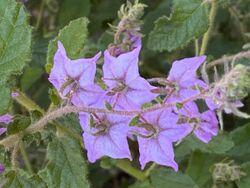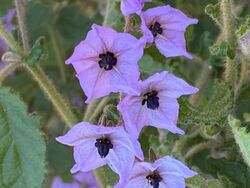Biology:Thomasia purpurea
| Thomasia purpurea | |
|---|---|

| |
| Scientific classification | |
| Kingdom: | Plantae |
| Clade: | Tracheophytes |
| Clade: | Angiosperms |
| Clade: | Eudicots |
| Clade: | Rosids |
| Order: | Malvales |
| Family: | Malvaceae |
| Genus: | Thomasia |
| Species: | T. purpurea
|
| Binomial name | |
| Thomasia purpurea (W.T.Aiton) J.Gay[1]
| |
| Synonyms[1] | |
| |
Thomasia purpurea is a small, flowering shrub in the family Malvaceae that is endemic to the southwest of Western Australia. It has green oblong-shaped leaves and pinkish purple flowers.
Description
Thomasia purpurea is an upright, slender shrub usually growing to between 0.3–1.2 m (1 ft 0 in–3 ft 11 in) high, stems covered in star-shaped hairs. It has oblong to narrow-oval shaped leaves, 1–3 cm (0.39–1.18 in) long, 7 mm (0.28 in) wide, hairy especially on the underside and wavy margins. The small flowers are cup-shaped, droopin, borne in clusters of 1–3 at the end of branches, lacking petals and calyx lobes pinkish purple. Flowering occurs between April and December.[2][3][4][5]
Taxonomy and naming
The species was first formally described by Swedish botanist Jonas Carlsson Dryander and the description was published in William Aiton's Hortus Kewensis in 1811 as Lasiopetalum purpureum.[6] The type specimen was collected by botanist Robert Brown from King George Sound in 1801. In 1821 French botanist Jacques Etienne Gay placed the species in the genus Thomasia.[7] The specific epithet (purpurea) means "purple".[8]
Distribution and habitat
This species grows in coastal regions of south-west Western Australia on ridges, flat lands, seasonally wet locations and sandy hills.[2][3]
References
- ↑ 1.0 1.1 "Thomasia purpurea". Australian Plant Census. https://biodiversity.org.au/nsl/services/apc-format/display/65854.
- ↑ 2.0 2.1 "Thomasia purpurea". FloraBase. Western Australian Government Department of Parks and Wildlife. https://florabase.dpaw.wa.gov.au/browse/profile/5094.
- ↑ 3.0 3.1 Grieg, Denise (1999). Field Guide to Australian Flowers. Australia: Averill Chase-New Holland. p. 410. ISBN 1864363347.
- ↑ Wrigley, John; Fagg, Murray (2001). Australian Native Plants. Australia: Reed New Holland. p. 476. ISBN 1876334304.
- ↑ Blake, Trevor L. (2021). Lantern bushes of Australia ; Thomasias & allied genera : a field and horticultural guide. Victoria: Australian Plants Society, Keilor Plains Group. pp. 48–49. ISBN 9780646839301.
- ↑ "Lasiopetalum purpureum". Australian Plant Name Index (APNI), IBIS database. Centre for Plant Biodiversity Research, Australian Government, Canberra. http://www.anbg.gov.au/cgi-bin/apni?TAXON_NAME=Lasiopetalum+purpureum. Retrieved 12 December 2011.
- ↑ "Thomasia purpurea". Australian Plant Name Index (APNI), IBIS database. Centre for Plant Biodiversity Research, Australian Government, Canberra. http://www.anbg.gov.au/cgi-bin/apni?TAXON_NAME=Thomasia+purpurea. Retrieved 12 December 2011.
- ↑ Sharr, Francis Aubi; George, Alex (2021). Western Australian Plant Names and Their Meanings (4th ed.). Kardinya, WA: Four Gables Press. p. 296. ISBN 9780958034180.
Wikidata ☰ Q7795563 entry
 |



